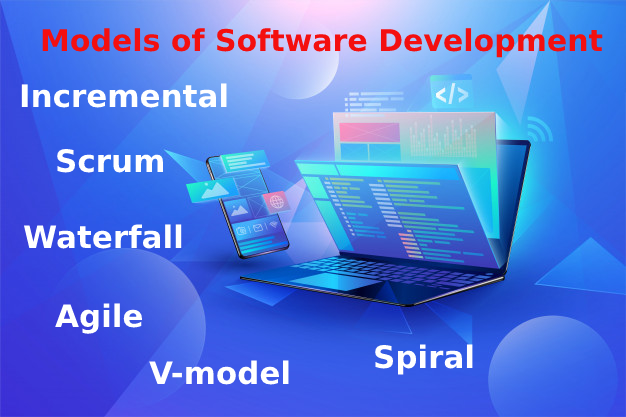The software lifecycle is a period from the moment someone decided to develop a product to the end of this product lifespan.
To simplify the processes of projecting, development, and release of a new product, specialists created models of the software development lifecycle.
Obviously, a crucial moment for choosing the most appropriate methodology is project requirements. Further, in the article, we’ll analyze the most popular models in software development.

Models of Software Development
Incremental Model
With this model, specialists linearly develop software in several increments (modifications). Due to this system, the software is improved regularly until its lifecycle is completed.
Project requirements are determined before the beginning of the work. Further, the development process is gradual where each version is developed and ready for use product.
Advantages:
- It is possible to see risks connected with expenses and deadline;
- A client can comment on each version of the product;
- The client gets used to the new methodology over time.
Disadvantages:
- Sometimes regular updates can break the system structure;
- Specialists should determined the functional system at the beginning of lifecycle to allocate iterations;
- The implementation schedule maybe not observed because of limited resources (material and executive ones).
Agile Model
This model of software development implies the usage of different approaches. It includes some approaches to software development that focus on iterative model usage. Also, this model uses a dynamic formulation of the requirements and their implementation during the constant interaction of self-organized working groups with various specialists.
Every iteration is a little project. One of the main ideas of agile methodology is face to face interaction between a client and e development team.
Advantages:
- Minimized risk;
- More simple paperwork management;
- All the team members make decisions quickly due to regular communication.
Disadvantages:
- Specialists rarely use this model for big projects;
- There are a lot of communications and meetings that influence the duration of the software development process;
- It is difficult to plan the work because of the continuous updates of requirements.
Waterfall Model
The essence of this model is that each stage is performed once and consecutively. Only after completion of the phase, you can proceed to the next one.
Advantages:
- Specialists regulate and execute all the project phases in strict sequence;
- Project requirements stay the same during the whole cycle;
- Strict completion of all the project stages allows planning resources and task completion date.
Disadvantages:
- QA engineers perform testing from the middle of a project;
- Often it is quite difficult to write requirements since they are unchanged and should be strictly determined;
- Finally, a user cannot make certain of the product quality unless it is completely developed.
V-model
This model is some kind of advanced version of the waterfall model since it helps to get rid of previous defects.
Its core is total control of the processes at all the stages of development to ensure that it’s time to move to the next phase. Testing begins at the stage of requirements formulation.
Advantages:
- Improved time management inside the quality assurance organizations;
- The implementation process has strictly regulated stages;
- Low risk and getting rid of potential bugs at the initial stages due to early testing.
Disadvantages:
- There are no actions to analyze risks;
- Impossible adaptation to new client’s requirements;
- The development process lasts too long (sometimes it takes even years). As a result, the product becomes irrelevant for the client.
Scrum
Scrum is a software development approach that focuses attention on high-quality control of product development.
There are different roles (Product Owner, Scrum Master, and Team) that help to strictly separate everybody’s responsibilities. Scrum Master is responsible for project success in general and works with a management department and a development team.
Product Owner develops software, assigns tasks, and makes final decisions for the project team. Meanwhile, Team is a coherent structure where success is measured not through the single employee’s work but a total.
In this model sprints last 1 – 4 weeks. After completion of each sprint the team shows a product build.
Advantages:
- Independence and self-organization of a team;
- Quick feedback between employees of different work areas;
- A tester participates in the project; this makes it possible to quickly add new functionality and launch the product with minimum functions.
Disadvantages:
- Sometimes clients don’t understand how this model works and it takes some time to make it clear for them;
- Since there is no documentation while product development, employees who know this product well become essential;
- Obviously, there is no way to plan a concrete date of work completion since everything depends on the previous sprint.
Spiral model
This model describes the software lifecycle in the form of a spiral. It starts at the stage of writing a plan and makes so-called whorls after each stage is completed.
Thus, at the end of each whorl, we get an integral mock-up that was under test and completes the whole build. If this mock-up meets all the requirements, then it is ready for production.
Advantages:
- Firstly, it’s flexible projecting;
- Also, there is enough attention to risk management;
- And finally, it is possible to add new functionality at the late stage of development.
Disadvantages:
- Usually, specialists use it for big projects;
- Risk assessment at each stage causes huge expenses;
- A situation, when a client can regularly give feedback, incites updated iterations; and this influences a term of software development.
In Conclusion
In the world of the IT industry, there are a lot of different methodologies of the software development lifecycle. The choice of one of them depends on defined requirements, product peculiarities, and payment model. Of course, every methodology reflects in others but still has its individual and distinctive features.










Leave A Comment